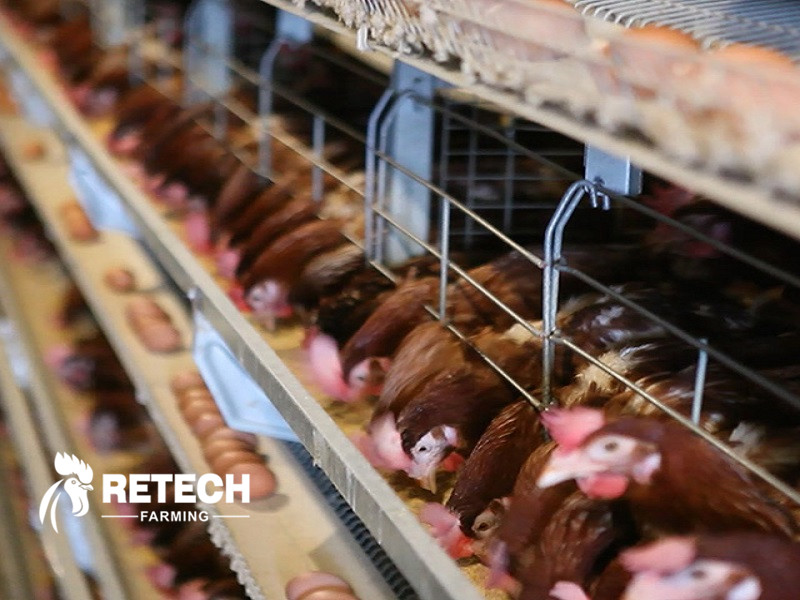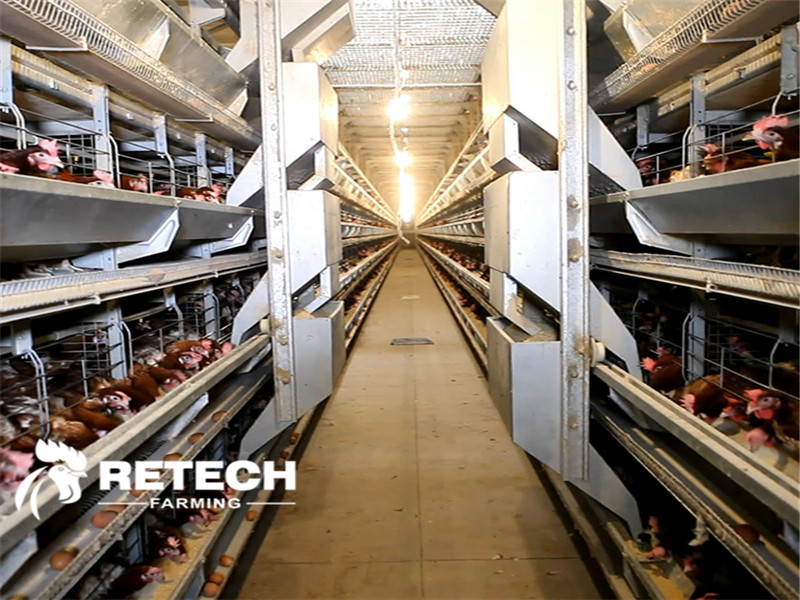Management problems and solutions of laying hen hair removal.
3.Management issues
1). Insufficient feeding
When the daily feeding amount of laying hens is controlled, or when the flock is in a state of starvation or semi-starvation, it is easy to peck feathers and cause hair loss. In the case of not being able to feed enough for a long time, laying hens will experience hair loss due to insufficient protein intake.
2). Water shortage
After the drinking water is administered, the water line is not cleaned in time, and the drinking nipple is blocked, resulting in a long-term water cut, especially in summer, which can cause severe stress hair loss, accompanied by a serious drop in egg production.

chicken farm
3). Stress
If some strong non-pathological stress occurs frequently, it will cause a significant reduction in egg production rate and induce molting, such as flock stress caused by birds, mice, cats and other animals entering the chicken house.
4). Stocking density
It mainly occurs in caged laying hens, with a small area and a large number of chickens. In addition, some laying hens are overweight, resulting in a larger body size, which in turn increases the friction between the chickens, resulting in broken feathers and broken off.
5). Cage quality
When chickens are eating and drinking, the neck feathers often rub against the front mesh wire when the head and neck extend out of the cage. Over time, the hen’s neck feathers will break or fall off.

battery chicken cage
6). Compete for food
During the feeding process, chickens will compete with each other and climb over each other. After a long time, there will be hair loss, especially the shedding of the back feathers.
4. Disease problems
1). Folliculitis
The diseases that cause abnormal hair loss in chickens are mostly folliculitis. If the environment of the chicken farm is poor, dark and humid, it will cause bacteria to breed. The chickens are not conducive to growth in such an environment. Chickens with folliculitis present with itching, frequent beak pecking, and extensive feather loss, and patches of red spots can be found on the bare skin.
2). Parasites
External parasites such as chicken lice and mites can cause laying hens to lose their hair. The usual symptoms are unbearable itching, restlessness, loss of appetite, decreased egg production, frequent pecking of feathers by sick chickens, and sometimes skin pecks and bleeding, causing feathers to fall off.
3). Intestinal diseases
Coccidiosis, intestinal bacterial diseases, these diseases often lead to nutrient absorption disorders, resulting in nutrient deficiencies, which in turn lead to hair loss in chickens.
5. The solutions
1). Provide chicken with balanced nutrition
Feed (premix) should be produced by large-scale regular manufacturers, which can ensure the needs of laying hens for vitamins and trace elements. Especially for farmers who have self-prepared feed, they must have balanced nutrition when matching the feed to ensure the nutrition required for chicken growth and production.
When the chicken flock is shedding, it is necessary to check the ratio of various nutrients in the feed formula according to the age of the chicken flock, and adjust it in time if there is a problem. In the current breeding environment, for farmers, the problem of mycotoxins in feed should be paid special attention.
2). Sufficient feed for chickens
Provide sufficient feed according to the age of the chickens to ensure that the chickens are fully fed. Timing, quantitative and fixed times of “feeding” method can be adopted when feeding, so as to ensure that the chickens eat well and the indicators are stable. When adopting the feeding method, the stocking density of the flock must be adjusted to ensure that the number of chickens in each cage is consistent, so as to avoid the phenomenon of unbalanced chickens and overeating between cages.
3). Choose the right cage
The chicken raising equipment produced by RETECH is selected, and the cages are selected according to the feeding volume of the single building in the field. The matching of the feeding quantity in the single cage and the feeding position must be considered to avoid the friction between the chicken neck and the front mesh. And in the process of feeding the chickens, there is a phenomenon of competition with each other. Provide a good breeding environment for each chicken.

H type battery cage
4). Control the light intensity
High stocking density and strong light can easily cause chickens to be irritable and pecking anus. If the light of the chicken house is very strong, when the chickens peck the anus, the chicken house should be properly shaded under the premise of ensuring ventilation.
During the high temperature period, cooling measures must be taken to keep the chickens in a temperature environment suitable for growth, reduce the breeding density and strengthen ventilation.
The light time must be fixed. If it is to be changed, it must be adjusted slowly, and the light time should be provided according to the growth stage of the chicken. Different growth stages provide different light time to promote its growth.
5). Do a good job in epidemic prevention and control
Disease prevention and control measures should be strengthened during feeding, and attention should be paid to environmental control in the chicken house, especially hygiene and disinfection measures must be in place to ensure the safe growth of chickens. After the disease is discovered, timely measures are taken to treat it to prevent the disease from getting worse.
6). Management of facilities and equipment
People raise equipment, and equipment raise chickens. The management and use of the equipment should be checked daily to ensure the normal operation of the equipment, and the problems of water interruption, fan failure and lighting should be avoided, so as to provide a good growth and production environment for the chickens.
In the actual production of laying hens, the causes of abnormal hair loss of laying hens are more complicated, some are caused by unilateral factors, and some are the result of the combined action of many factors. Breeding friends should correctly analyze and find the cause according to the actual situation, and target Problems are given correct adjustment, prevention and treatment measures to ensure the health of the flock and ensure economic benefits.


